As a magazine no stranger to a Roland TB-303 clone review, we decided to put the Donner Essential B1 analog monophonic synth to the test. Initially we were quite excited to get this unit in for review. With a more polished aesthetic, rectangular rubber pads in a keyboard layout, USB-C and DIN MIDI connectivity, a 1/4″ output and onboard effects, this was a bass synth that appeared to be reaching for more. Unfortunately, the design didn’t measure up to the poor sound quality, tweak-ability and user experience.
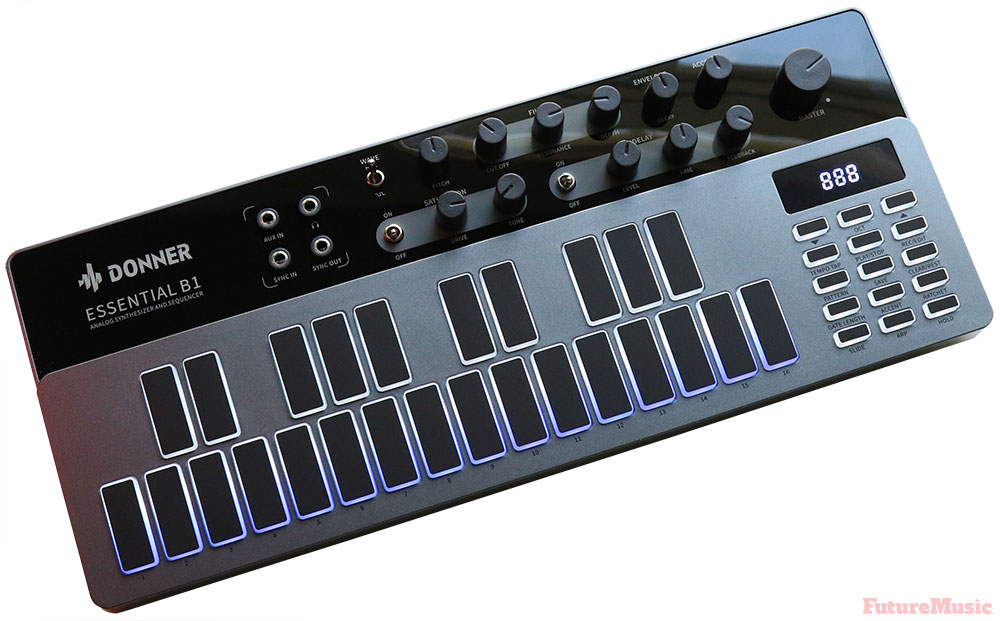

For a limited time only! Up to 80% off all Waves Bundles. PLUS click the banner above or the Go button for an additional 10%! This is Waves best deal yet! Get yours today before this special ends! Go!
While Fatboy Slim believes everyone needs a 303, and we certainly can’t disagree, no one needs a Donner B1. It’s just one disappointment after another. First off, those nice-looking, LED backlit keyboard pads are not velocity sensitive, nor have aftertouch, two big misses, which alone could have set this model apart from competitors. There’s plenty of real estate available, but the knobs are small and cheap and cramped together. Three junk bin toggle switches are present for mundane duties, such as selecting either saw or square waves, and turning on/off the lackluster effects.
While Fatboy Slim believes everyone needs a 303, no one needs a Donner B1, it’s just one disappointment after another…
The word Donner is the German name for “thunder,” but the sound quality of the B1 is nothing close. The reedy and thin tones that the B1 spits out won’t even impress your pets, never mind a club full of acid techno heads. The effects are unimpressive at best and are probably derivatives from Donner’s lineup of garbage guitar pedals. The Saturation effect turns your sound into the remnants of burnt food at the bottom of pot that was left on the stove too long. The Delay, something they obviously tried to copy from a Boss pedal, is sloppy and dull.

The B1 features a single oscillator with sawtooth and square waveforms, that deliver the typical range of sounds for a monophonic synth. You can achieve the typical deep bass all the way to acid squelching madness with the filter, but the small knobs deliver limited range and sometimes feel like they “step” while being swept in either direction. Definitely not what you want for evolving acid builds.
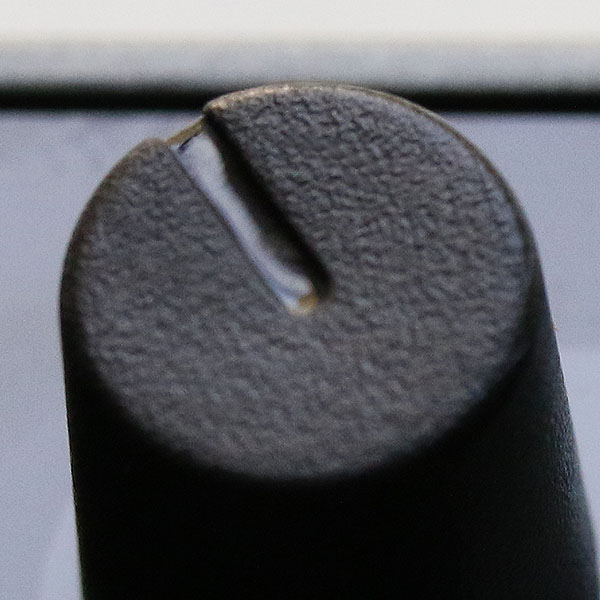
The Cheap & Small Knobs Fall Way Short
The sequencer allows you to record and edit in one of the 128 available program slots. The B1 comes preprogramed with preset patterns in every slot, and to our shock, they weren’t as bad as you think they would be considering the unit’s serious deficits. The sequencer allows you to enter up to 16 steps, change gate lengths, and enter accents and slides via the pads and telephone number keypad on the right. Donner did add a ratchet feature to the sequencer, which is a great idea, but there is no way to record patterns in real time with the pads while the sequencer is running, or turn the arpeggiator workouts into patterns, or even chain them.
The companion app is appalling. No, appalling may be too generous. It’s probably the worst companion app for a synth we’ve ever experienced. Modeled after the Behringer Synth Tool app, which will never win any awards, the B1 app falls short in every category. In fact, even having a companion app for this synth for anything other than firmware updates is ridiculous. Worse, basic functions, like setting the units send/receive MIDI channels, must be performed with the companion app and cannot be achieved with a button combo on the unit.
Insult To Injury
Instead, an annoying Power On Command is required for a simple MIDI channel change. We reached out to Donner via their Support email to find out if there was any mechanisms for simple Utility changes since the included manual would be more useful as toilet paper, and never got an answer to this question – despite going back and forth a few times.
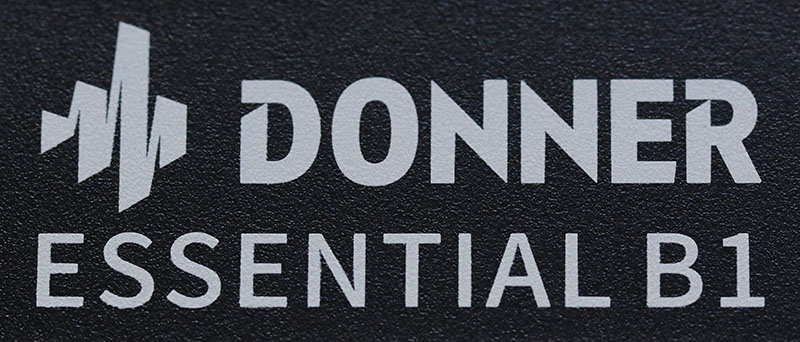
The companion app is appalling…It’s probably the worst companion app for a synth we’ve ever experienced.
The four 3.5mm mini jacks on the top of the unit are Sync In, Sync Out, Aux In and Headphones. The type of sync can be modified to different formats using the aforementioned Donner software, which is acceptable, but something that could easily be achieved with a button combo.
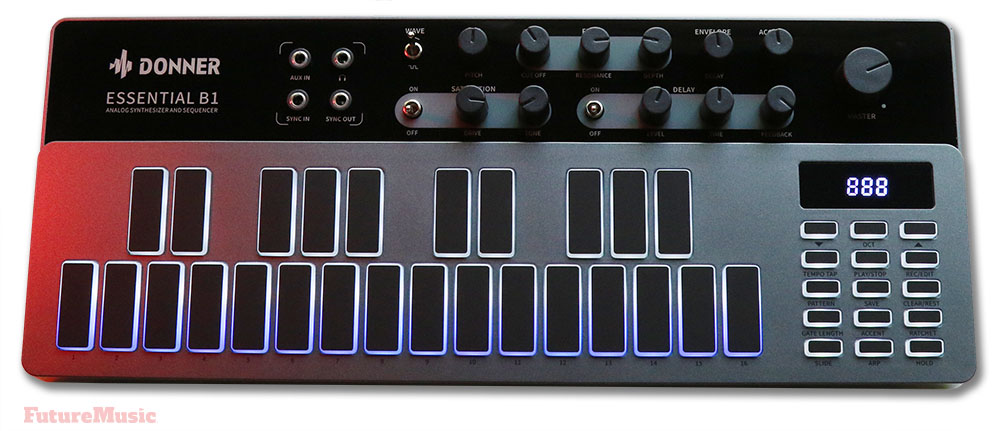
MIDI Designer Is Now Free!
MIDI Designer Pro X is now free to download! MIDI Designer Pro X is a professional-grade MIDI controller platform for iPhone, iPad and Mac. User-contributed layouts let you control everything from Ableton to Yamaha out of the box. Go beyond hardware and express your musical vision. Check out out now!

Donner Essential B1 Specifications:
- Monophonic Analog Synthesizer
- VCF: 1 low pass
- Oscillators: 1 / Square + Saw Waveforms
- Control Knobs: SATURATION knob, DRIVE knob, TONE knob, DELAY knob, LEVEL knob, TIME knob, FEEDBACK knob
- Control Buttons: UP and DOWN, TRANSPOSE, PATTERN, TEMPO/TAP, PLAY/STOP, CLEAR, WRITE, BAR, SIGNATURE, DOTTED
- Power Input: DC input connector
- Power Adaptor: 9VDC 500mA inner positive
- MIDI IN/OUT: MIDI In & MIDI Out, 5-pin IN
- USB (MIDI): USB 2.0, Type C
- Outputs: Line output: 1/4″ TRS
- Headphones: 3.5mm TRS
- Supported Operating Systems: Win 7 or higher / Mac OS X 10.6.8 or higher
- Inputs & Outputs (TS 3.5mm): AUX in: maximum input +5 dBu, Sync in: More than 2.5V
- Size (L/W/H): 32.5 x 12 x 5.6 cm
- Weight: 0.62kg (1.37 lbs)
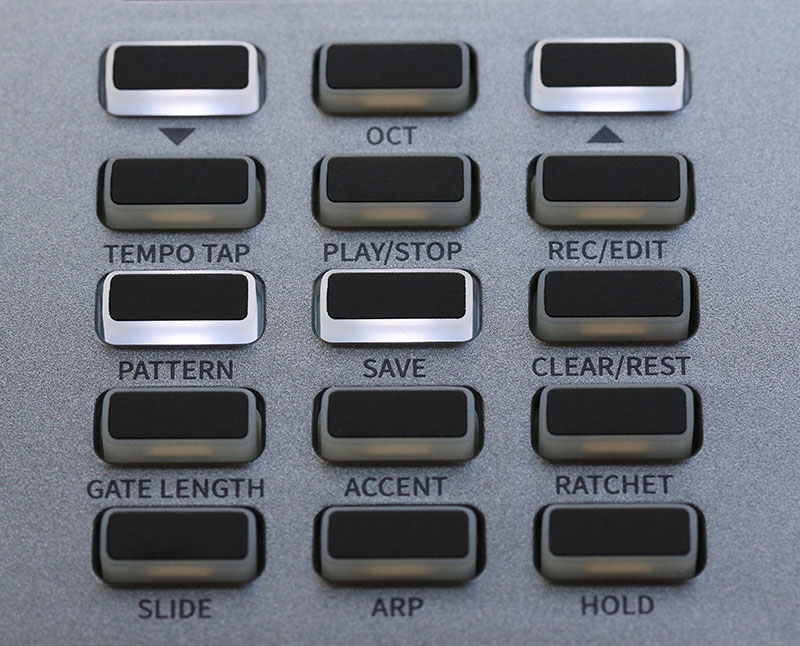
Donner parsed the tweak action into two sections: Filter with Cutoff, Resonance and Depth, and Accent and Envelope off to the right. The Accent function is accessible – hard to really mess that up, but the Envelope doesn’t provide the greasy or slinky textures of the 303. The Resonance is brittle and frankly, quite harsh, and with the limited range gets squelchy way too fast. The filter, as mentioned above, is steppy and has a hard slope, eliminating smooth sweeps and subtle builds.

The easiest way for electronic musicians to get their music onto Spotify, Apple Music, iTunes, Amazon Music, Tidal, Instagram, Facebook, TikTok, Pandora, Twitch & much more! Click the banner above or the Go Button to save 7% off of your signup! Go!
Conclusion
Nope. The excitement over the B1’s design almost immediately faded once our testers got their hands on the unit. There is actually nothing “Essential” about the Essential B1. Donner did almost nothing to elevate the 303 monophonic analog sound and even small advancements like the rachet function weren’t enough to overlook the B1’s serious shortcomings. We understand it’s inexpensive, but for the same price you should buy the Behringer TD-3 instead. Not Recommended.
Donner Essential B1 Rating: 70%
Cheers:
+ Aesthetic
+ Full Size MIDI I/O
+ 1/4″ Output
+ USB-C
Jeers:
– Sound Quality
– Filter Quality
– Tweak-ability
– Small Knobs
– Companion App
– Functionality
– Utility Changes
– Customer Support
– Manual

Donner Essential B1 costs $129.
The Future: Donner missed some big opportunities with the B1 to stand out in a very crowded 303 clone market. While the design showed some promise, the tiny, crowded knobs are a head-scratcher. With the size of the unit, those knobs could have been more more beefy with a much wider range for the cutoff, resonance and envelope. Only a four-year-old could possibly fit their fingers around a knob without hitting another one. The note on / note off pads are another huge miss. Adding velocity would have added another dimension and aftertouch would have allowed bends and tweaks beyond slide and accent. Finally, the app is just trash and needs to be rewritten from the ground up or just used for firmware updates. In fact, ALL of the unit’s functionality should be able to be performed on the unit and not in an app.








